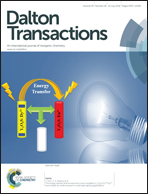S-shaped decanuclear heterometallic [Ni8Ln2] complexes [Ln(iii) = Gd, Tb, Dy and Ho]: theoretical modeling of the magnetic properties of the gadolinium analogue†
Abstract
The reaction of 8-quinolinol-2-carboaldoxime (LH2) with NiII and LnIII salts afforded the heterometallic decanuclear compounds [Ni8Dy2(μ3-OH)2(L)8(LH)2(H2O)6](ClO4)2·16H2O (1), [Ni8Gd2(μ3-OH)2(L)8(LH)2(H2O)4(MeOH)2](NO3)2·12H2O (2), [Ni8Ho2(μ3-OH)2(L)8(LH)2(H2O)4(MeOH)2](ClO4)2·2MeOH·12H2O (3) and [Ni8Tb2 (μ3-OH)2(L)8(LH)2(MeOH)4(OMe)2]·2CH2Cl2·8H2O (4). While compounds 1–3 are dicationic, compound 4 is neutral. These compounds possess an S-shaped architecture and comprise a long chain of metal ions bound to each other. In all the complexes, the eight NiII and two LnIII ions of the multimetallic ensemble are hold together by two μ3-OH, eight dianionic (L2−) and two monoanionic oxime ligands (LH−) whereas compound 4 has two μ3-OH, eight dianionic (L2−), two monoanionic oxime ligands (LH−) and two terminal methoxy (MeO−) ligands. The central portion of the S-shaped molecular wire is made up of an octanuclear NiII ensemble which has at its two ends the LnIII caps. Magnetic studies on 1–4 reveal that the magnetic interactions between neighboring metal ions are negligible at room temperature. On the other hand, at lower temperatures in all the compounds anti-ferromagnetic interactions seem to be dominated. Analysis of the magnetic data for the GdIII derivative indicates NiII–NiII anti-ferromagnetic interactions and GdIII–NiII ferromagnetic interactions at low temperatures. A theoretical density functional study on the magnetic behavior of the GdIII derivative suggests that while the weak ferromagnetic interaction between GdIII and NiII is in line with the expectation of the magnetic interactions between orthogonal d and f orbitals, antiferromagnetic NiII–NiII interactions are related to the wide Ni–O–Ni angles (∼102°) and quasi-planar conformation of the Ni2O2 core.
![Graphical abstract: S-shaped decanuclear heterometallic [Ni8Ln2] complexes [Ln(iii) = Gd, Tb, Dy and Ho]: theoretical modeling of the magnetic properties of the gadolinium analogue](/en/Image/Get?imageInfo.ImageType=GA&imageInfo.ImageIdentifier.ManuscriptID=C4DT00465E&imageInfo.ImageIdentifier.Year=2014)

 Please wait while we load your content...
Please wait while we load your content...